After forty years, you’d think we’d be done roasting the Fiero with gags about its propensity to catch on fire (sorry about the pun). But hey, quite a few of them did go up in flames, so it’s hardly untrue, and the “hot car” jokes write themselves. Like so many hackneyed judgments of vehicles on “worst cars ever” lists, there’s always a kernel of truth that somehow gets transformed into a mountain over time, and Pontiac’s mid-engined sports machine is no different.
General Motors is hardly a stranger to making cars that were great conceptually but let down by a significant flaw or two. The Fiero was guilty of that as well, but it turns out that the fiery horror stories were limited to a very select few examples of a very specific early version of this Pontiac. The issue was not even remotely as widespread as some might think, but that doesn’t mean mistakes weren’t made. Boy, were they ever, let me tell you.
Spacer

If Hall & Oates Were A Car
As you can imagine, this fine website is pretty much the bane of my existence. I waste most of my off-real-job time writing and drawing for you, but if I didn’t, it’s not like I would watch Netflix or something. I hate going through twenty episodes of a show where some unlikely hero gets what they want, gets knocked down, rises again, and then fails in a never-ending pattern until writers or the viewers get sick of it.

However, in researching old General Motors cars, I often get caught up in the same damn type of drama. The Fiero, in particular, is a protagonist that succeeded against the odds just to exist, and the whole world worked against it.

Conceived in the late seventies as a two-seater mid-engined V6 sports car, the idea was quickly nixed by GM management that saw it as a competition for the Corvette. Ah, but the fans of the idea persevered, as I mentioned in a post a while back:
The champions of the Fiero pushed the concept through GM’s bureaucracy by selling it to top brass as an economical two-seat “commuter car” in the same way that you might try to justify a Honda CBR Fireblade to your spouse as an economical way to get to work.
With the second energy crisis, the ruse worked. Naturally, it was laughable since the creators knew all along that it was going to be a sports car. You might scoff at its humble beginnings in late 1983 with a Chevette front suspension and X-Car Iron Duke (four cylinder) drivetrain shoved in back, but the fact that they got the thing to exist in the first place is practically miraculous.

Yes, that’s right. The initial Fiero was indeed an innovative plastic skin that repelled baseballs wrapped around a parts bin special. Crude as might have been, most of those parts had the kinks worked out of them. Well, at least that’s what you’d think if this weren’t a GM tragedy.
You’re The Duke, A Number 1
After the disaster that was the aluminum-block Vega motor in the early seventies, General Motors took no chances with the replacement engine for their compact cars in 1977. Dubbed the “Iron Duke,” this four-cylinder was named for the material that made up its durable block. Perhaps as further insurance against the potential pitfalls of attempting even mere modernity, let alone innovation, the engine even reverted to pushrods instead of an overhead cam to actuate the valves.
No, this was not even remotely a rev-happy Alfa Romeo mill. In operation, the Iron Duke sounds like the old LLV idling in front of your house as the postman drops the latest issue of Taillights Monthly into the box. That’s right, those thirty-plus-year-old mail trucks are powered by the same Iron Duke four-cylinder. If that doesn’t prove the durability of this old motor, what does?

Even the most bulletproof design won’t be bulletproof if you build it wrong, however. In the case of the Iron Duke, the site Enginebuiler.com summed up the tale of woe:
According to inside GM sources, a bad patch of connecting rods (due to poor metallurgy) made it past quality control…The bad rods were mixed in with the good rods and sorted for length and put into sets…Some engines had one bad rod, some did not — it was a lottery for the owner of the vehicle.
The Iron Duke was used in a number of GM products at the time, so did all of these “bad” rods end up in Fieros? I couldn’t find any evidence of that, but I can tell you one thing: the Fiero was not the car you wanted to put a break-prone rod into.

It’s impressive how Pontiac was able to take all of these family car components to make a low-slung sports machine. How, you might ask, did the engineers get such a presumably tall engine to fit within the height of the wedge-y Fiero? Well, maybe you don’t want to know.
Fier-oh-NO
There have been many “dry sump” cars built over the years, but doing so with a high-volume American street vehicle would be ill-advised. Chopping the height of an oil pan and decreasing the capacity to a mere three quarts in the name of making the Duke fit into the Fiero sounds like a recipe for disaster – and it was – but that’s what General Motors did.
In effect, the Fiero was always running a quart low. Few owners checked the dipstick of their nearly-new car at every gas stop; they did, however, often rev the crap out of their Iron Duke since this was supposed to be a sports car and you sure as hell had to punch the gas to get every one of the 92 horsepower out of it. You can see where this is going. If you lost the connecting rod lottery and also never opened the engine cover to check the sump level, that combination of poor choices got you free viewing window in your Iron Duke block that led to more exciting surprises.
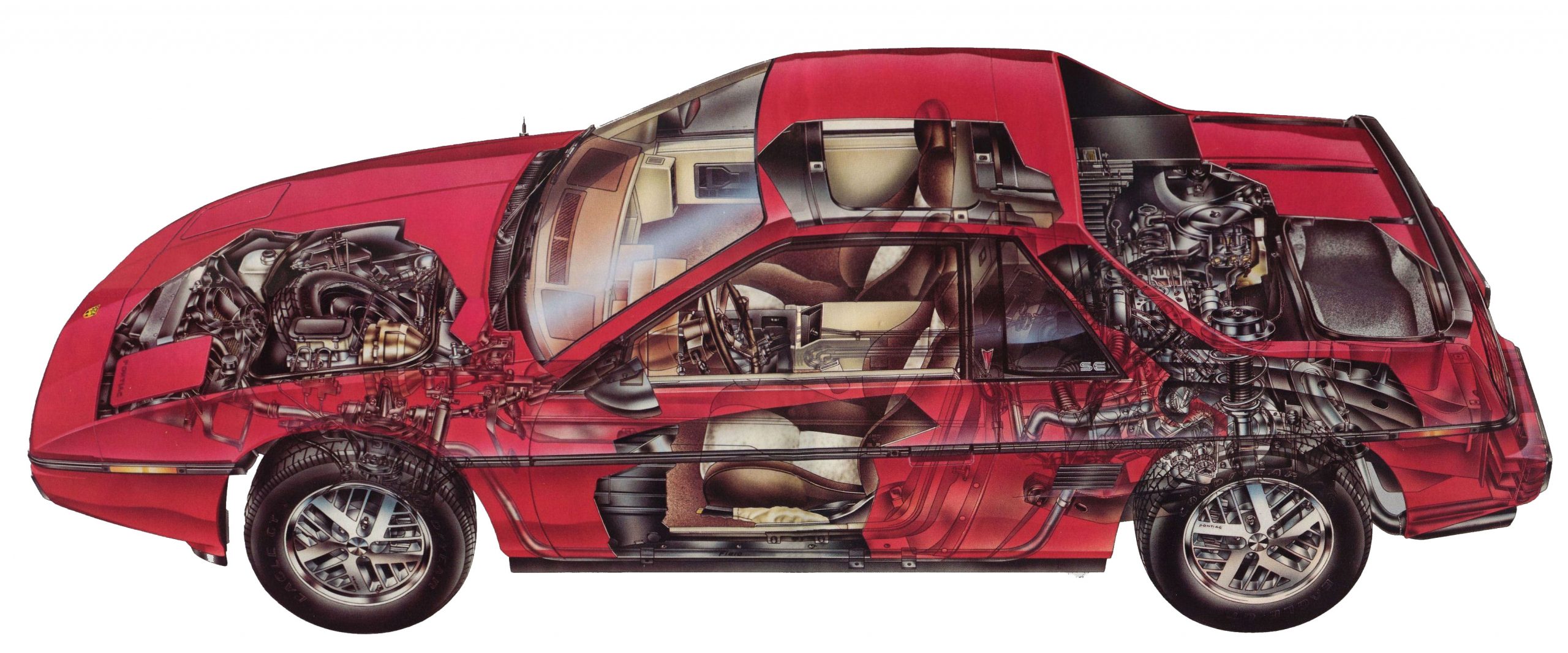
A thrown rod is a catastrophic thing to happen in any car, but an Iron Duke in, say, an S-10 pickup or Chevy Monza tossed a rod, you’d probably just walk home and make plans for a tow to the shop. It wasn’t that easy with the Fiero. You see, the engine bay behind the passenger compartment was quite tight and hot. It didn’t help that, as clearly shown in the cutaway illustration above, the catalytic converter and muffler were essentially behind and beneath the motor, not further back as packaged in a conventional front-engine ride. That meant all of the oil pouring out of your now-ventilated block ended up on super-heated exhaust parts, which ignited the oil and created a mini inferno. I’ve read that the plastic body panels burned with a very odd-colored glow that further added to the hype of the Great Incendiary Sports Car.
The question is, how bad was the problem really? As in most of these situations, figures vary wildly, but the number of Fiero engine fires has been listed as anywhere from 260 to 300 incidents. There were ten reported injuries, but nothing serious or close to fatalities. With over 100,000 Fieros built in the first year, and all of them at that point Iron Duke-powered, that equates to about one fire in every 300 to 400 cars, or a fraction of a percent. Regardless, Pontiac was forced to recall all 1984 models in late 1987 to make “repairs,” which honestly were a bit laughable:
- Check and correct any engine rod knocks, fluid leaks, or misrouted hoses and wires.
- Change the oil and air filter, and use four quarts of oil instead of three.
- Install a new dipstick and radiator cap.
- Affix a label reading ‘Check Engine Oil at Every Fuel Fill.’
- Authorize Pontiac dealers to provide air and oil filter changes as well as oil changes for a reduced rate of $10 for six years or 60,000 miles from the original purchase date.
- Ask owners who have had repairs related to the condition to submit receipts for possible reimbursement by GM.
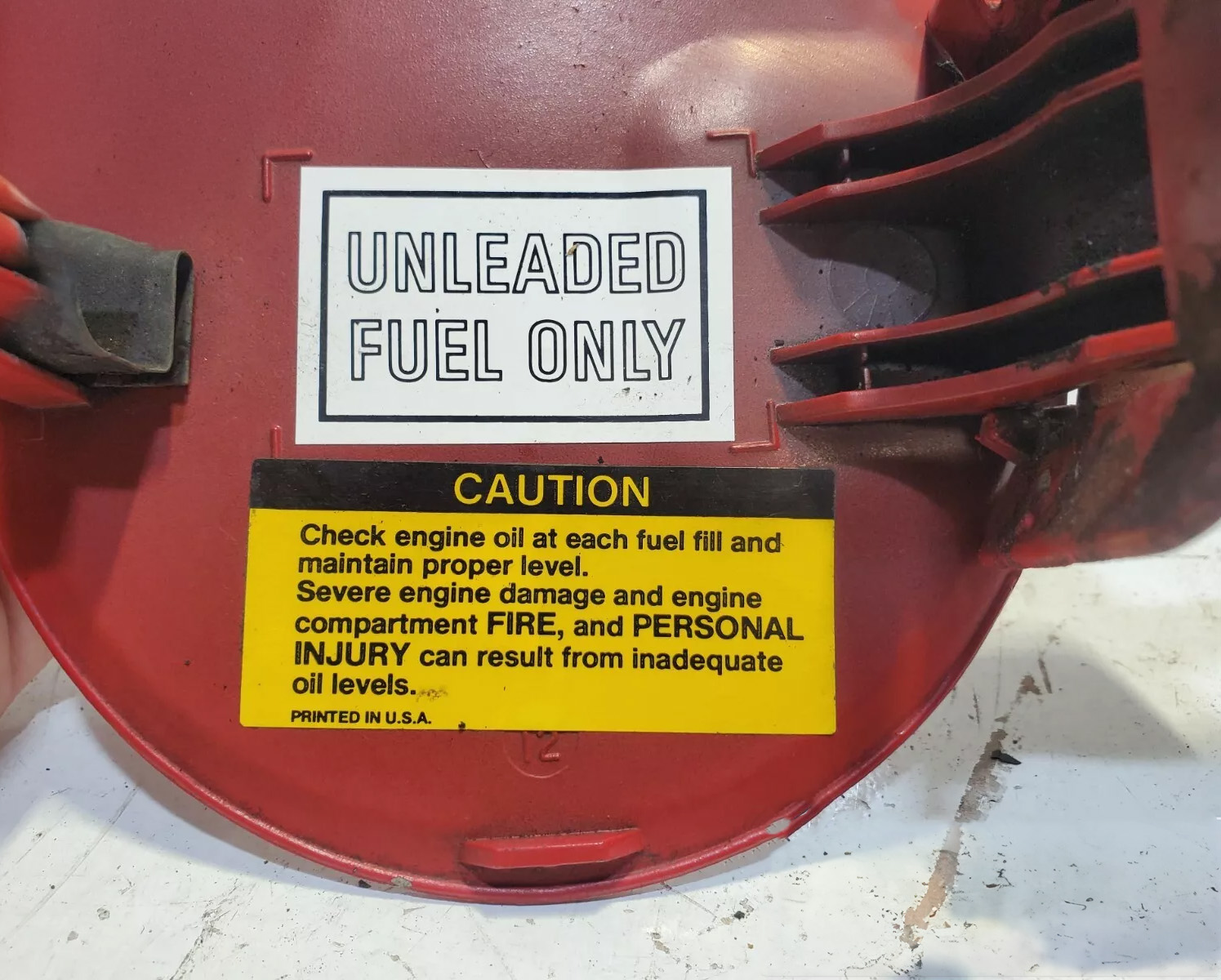
That’s right! Overfilling the sump and putting a sticker on the gas cap door telling you to check the oil! Is that not the greatest There-I-Fixed-It solution ever? Also, that “possible reimbursement by GM” for your burned-out Fiero hulk sounds unlikely. Be sure to bring in your receipts, and a good attorney.
No, “Fiero” Does Not Mean “Fire”
Regardless of the “fix”, the damage was done; in typical GM fashion for the time, the underdeveloped early models killed the far, far better later examples. You just know that this was exactly what the GM bean counters that never wanted this car in the first place were waiting for with a sickle in hand, ready to kill this poor car once and for all in 1988.

Obviously, none of this is an issue now. Today, one might assume that any running Iron Duke Fiero would have experienced a failure by now. Much of that is also a moot point since the more desirable and collectible 2.8-liter V6-powered Pontiac sports cars that you actually want have no such issues at all. I’m certainly not disparaging the terror of having your new sports car ignite, and even one car that turns into a bonfire is one too many. Still, does that rather small number of failures equate to something that should put it onto a “worst cars” list? I don’t think so.
I’ll tell you one thing, though: in today’s crazy world of $60,000 1990s Honda Civic Si, any undeserved bad press that can keep values of one of General Motors’ coolest products ever within the reach of broke GenXers isn’t all bad. I say let the myth stand.

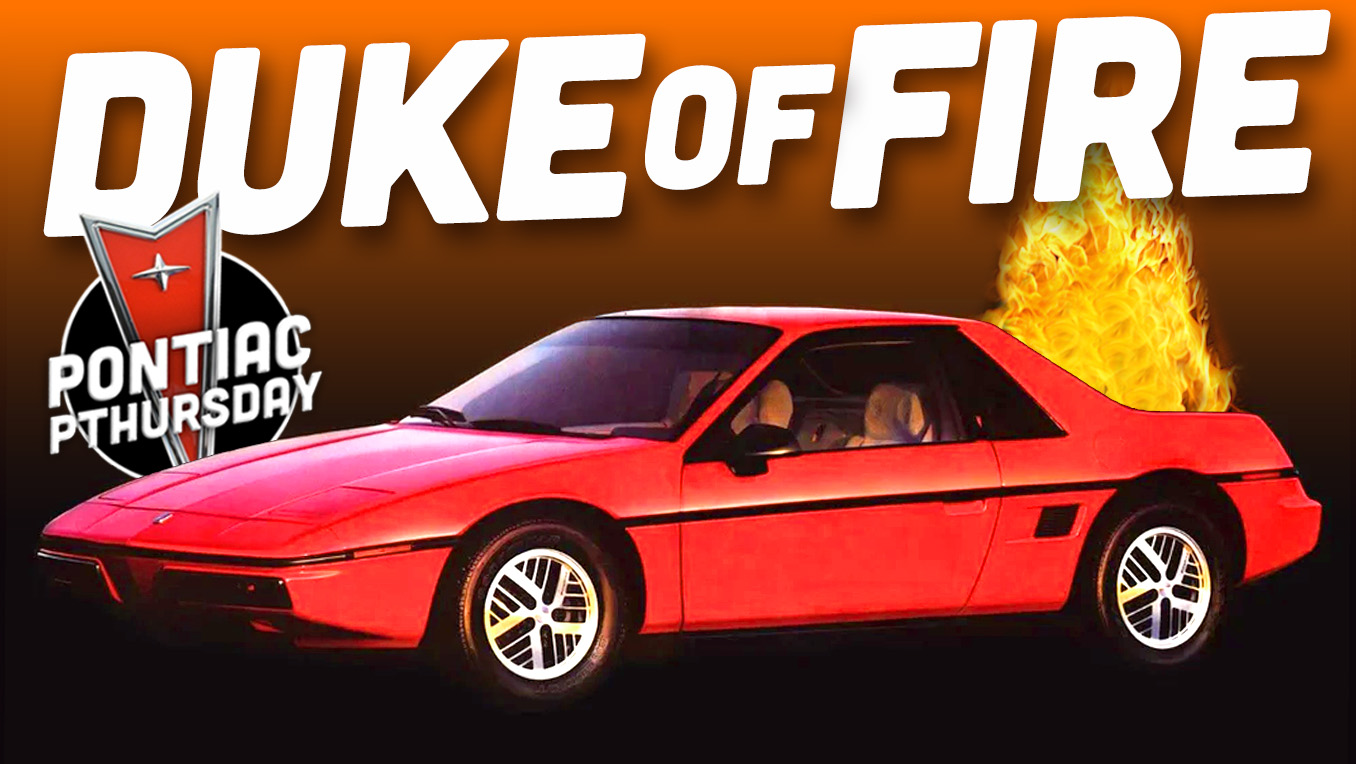



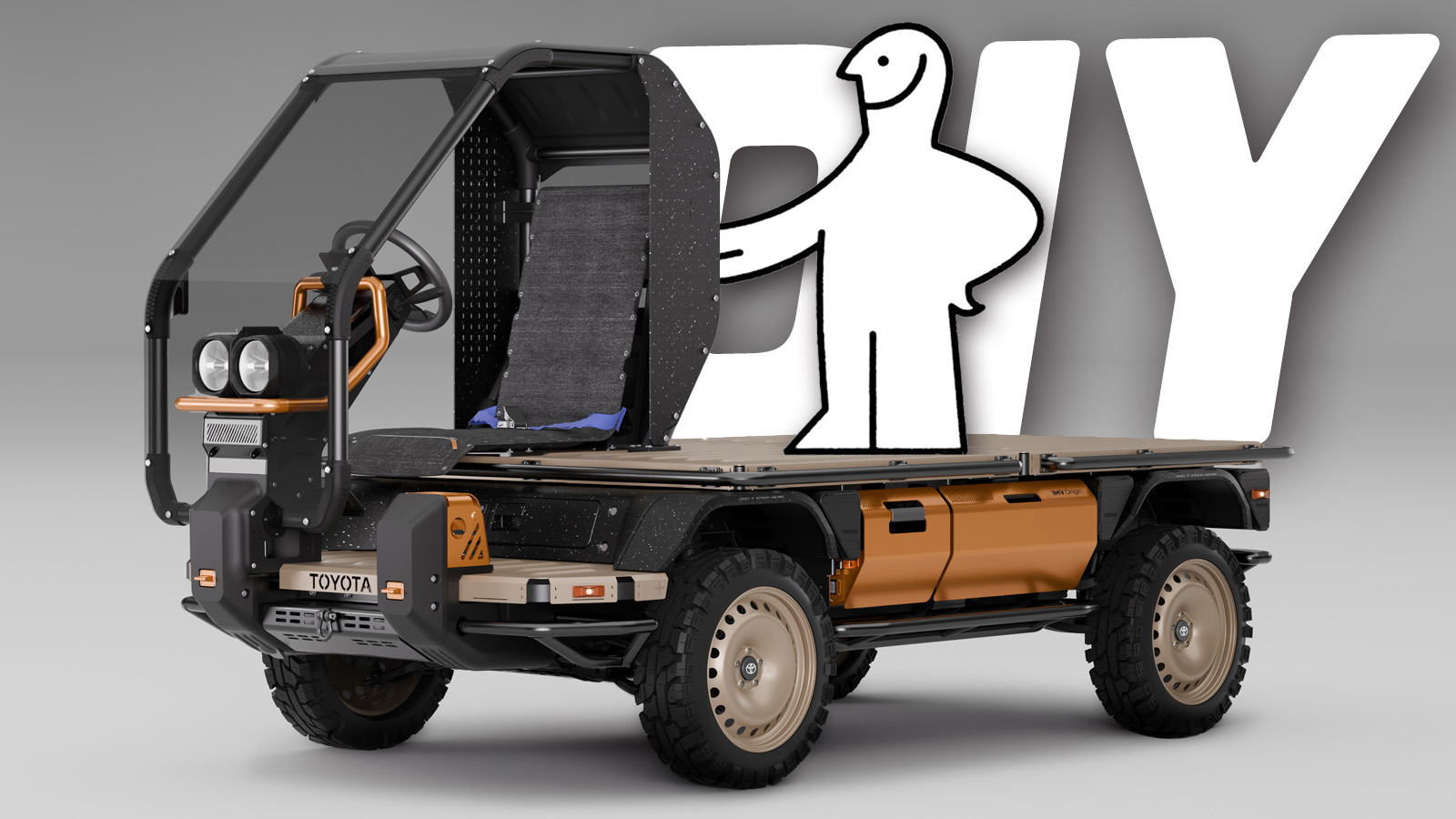
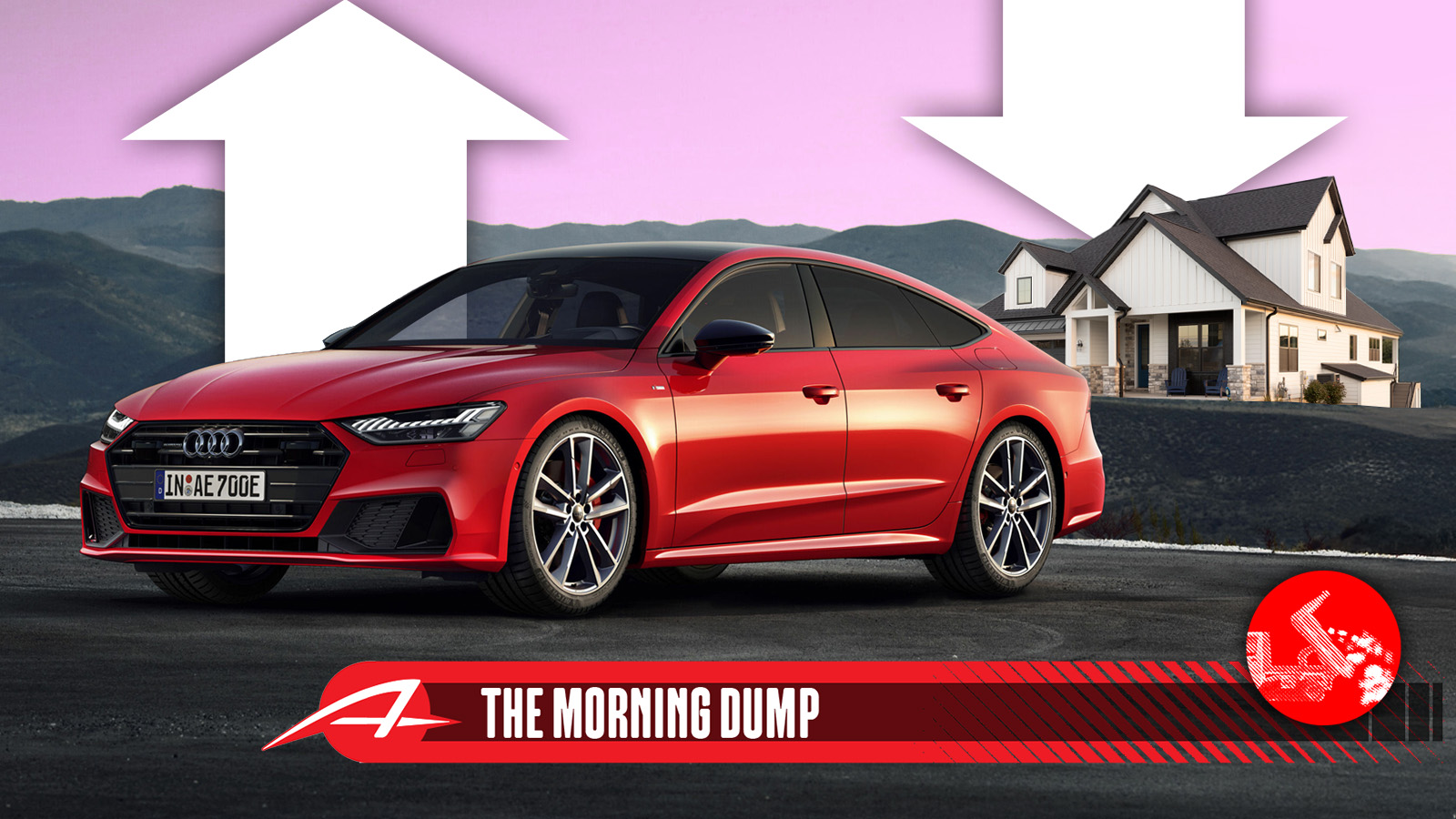
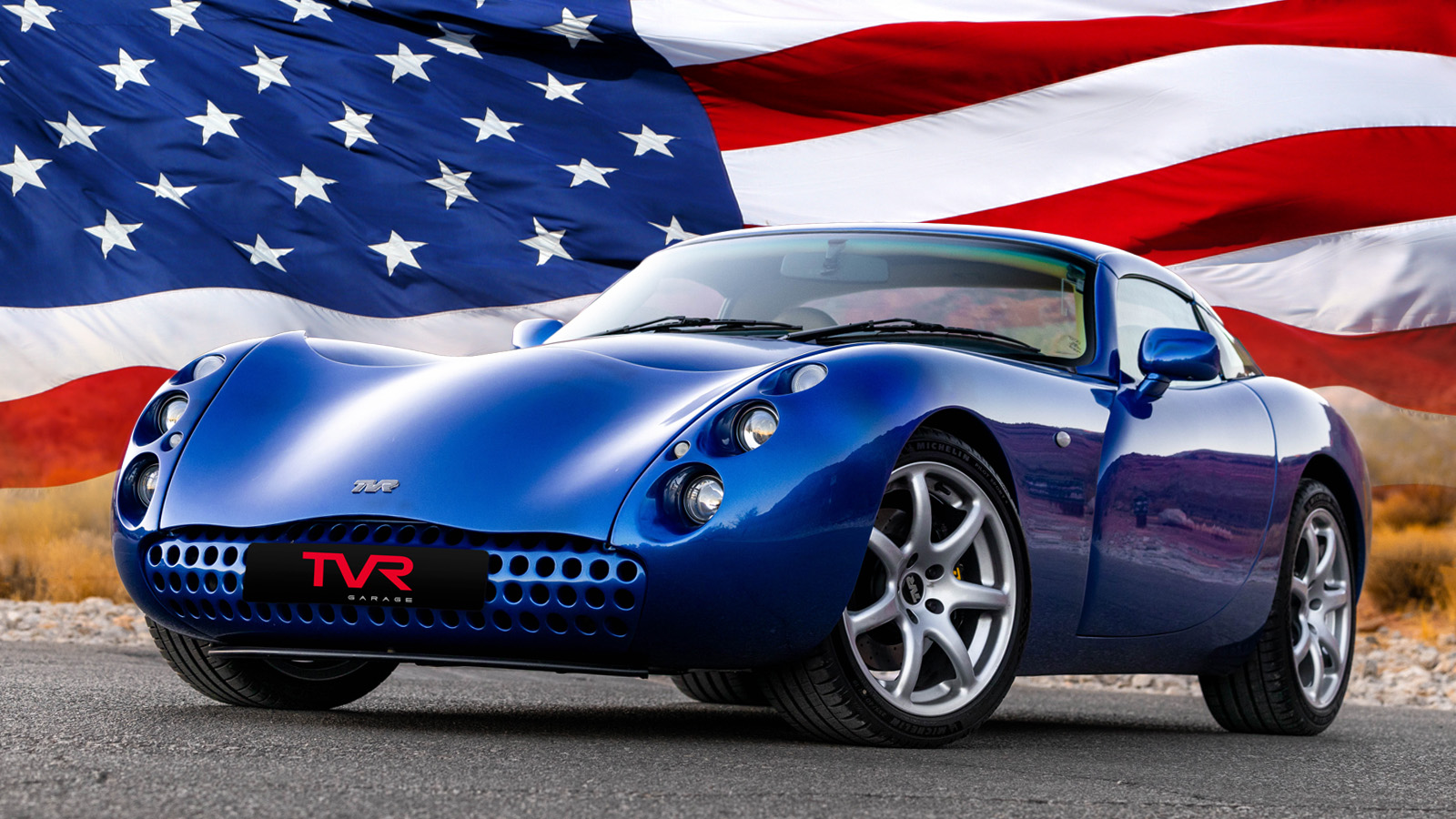
A dear friend went out and bought an ’84 and yes, I thought it was incredibly cool even though I was well aware of its humble powerplant. If you sit low enough to the ground, 40mph feels like 70mph and all that.
Heretofore however, I’d never learned about the connecting-rod lottery nor the brilliant profile-lowering oil pan design. Thank you for giving me something I need not mention to my friend who, yes, still owns and garages his pride and joy all these years later.
Daryl Hall and John Oates 1985 tour was sponsored by … Pontiac Fiero.
So Bishop, I can’t go for that bashing of the Fiero. It is clearly out of touch. And besides, you didn’t have to be a rich girl to own one. And after 1988, all we could say was “She’s Gone.”
As a fan of the Fiero, I’m afraid I can’t go for that. No can do.
Typical quality. These cars were terrible in many respects-they rattled, squeaked and howled at every possible moment you could think of.
And, I don’t expect these cars to have hit 50k miles, let alone 100k miles.
I seem to remember that due to lack of space, the oil filter was *inside* the oil pan, in a somewhat similar fashion to the VW flat 4, but it was a fairly large cartridge filter.
The oil pan drain plug was about 100mm in diameter, and when you unscrewed it, the filter came down with the plug.
Fuego did in fact mean fire, and they didn’t set the world on fire
My wife had one of these pieces of excrement when I first met her. An early build 2M4 base model, stick shift, no air, etc. GM replaced the motor at 40k and she never had any engine problems after that. It also taught her to check her oil regularly, a habit she still follows today, so I guess some good did come out of that ownership experience.
That car was a regular at the dealership and she was on a first name basis with the service manager.
I bought a Fiero in the 90’s that had a bad rod knock. That was fine, as my plan was to V8 swap it, but I decided to drive it 15 miles home to save the towing fee.
The knock got worse and worse until, on a long downhill, BOOM! And then silence.
At the bottom of the hill, I stepped on the gas, and the engine was still running! Zero oil pressure, three connecting rods remaining, and that thing made it all the way home. Iron duke!!
Reinforces the ole ‘nothing runs badly longer than a GM’!
Happens with a lot of new vehicles too sadly. the Bad valves in the 2.7 v6’s in the Bronco made the news enough for people to still be wary of them. though I do know the nano V6’s also have plenty of historical issues like plastic oil pans that leaked early on and oil fittings to the turbos.
Pintos and rear end hits along with saddle bag fuel tanks on S10’s. GM however seems to have some issues up front, then fix the issues and then promptly cut the program. For enthusiasts, it can be frustrating, but also a positive as you can often get the fixed models for earlier model pricing because the majority of the public does not know any better.
Ford Triton V8’s and what displacement and years are good and not good come to mind here.
You can’t spell Fiero without Fire.
Or “rife”.
Or ore
The most under-appreciated part of this piece is: “…the postman drops the latest issue of Taillights Monthly into the box.”
Discreetly, of course.
I feel, personally, called out.
My dad was into stage rally back in the day. I remember being with him at a dealership when they had a new (or maybe pre-production) model on the floor dressed out in cage and assorted rally gear. He couldn’t stop talking about it.
Of course years later he had a 1st gen MR2. (I’ve had two as well.)
and this is why they earned the nickname “iron puke”
I think it was about reliability, ID’s were generally considered reliable at the time, though Fiero might have sullied the name a bit. Sports cars of the time were never very powerful. Unless some American shoehorned a V8 in I suppose. But the Fiero with a 4 fit the same mold as X19’s, Porsche 914’s and Triumph TR7’s in that they were modern style and if running were at least entertaining to drive these slow cars fast.
The TR7 was front-engined. It merely tried to co-op the wedge look made popular by Gandini, who penned the X1/9.
A friend of mine had a Fiero back in the 90’s. Nothing caught on fire, but he did point out a pretty funny/not-so-funny design flaw. The space-saving spare tire fits snugly in the frunk. If you get a flat tire, your regular-sized flat tire/wheel do NOT fit in the frunk. If you have a passenger, you have to choose between your passenger and your wheel.
Not true. The rear trunk holds a full size tire.
I had the pleasure(?) of driving by a Fiero in full conflagration mode on the highway about 30 years ago. It was a very bright fire.
I remember the automotive press being very upset back when they canceled it that GM often kills of cars just as they get them right.
Also back in the 1980s if people wanted a 2 seat rear engine car they bought a MR-2 from Toyota and if they had “buy American” patriotism then they got a Fiero, and if they were poor they got an X-19.
Don’t forget if they weren’t willing to go the mid-motor route but still demanded only 2 seats, they could buy the somewhat inexplicable Ford EXP. Which almost nobody did.
I remember the neighbor girl I grew up with, her grandmother bought her a new escort gt because she wanted to get more of her friends in the car than an exp. I do not like that I remember all theses 1980s cars as new. We knew then that they were garbage but better garbage than 1970s cars.
That’s a very good point that I think gets lost in our usual historicism with respect to cars. Sure, 80s cars weren’t good in an absolute sense, but they were in a relative sense. Fuel injection, molded plastic, and at least a vague sense that firms acknowleged they were competing against quality foreign made stuff provided a sense things were gettting better, even if it would take a while longer for it to really come true.
As a teenager I even liked the Chevy Beretta as it was actually OK looking when introduced. I was shocked at the rounded look of the Taurus and Tempo after looking at big boxy boats from the 1970s. Yes you could tell the designers were trying and the quality was catching up.
Me too – so much so I got one in the 90s! A fun runabout that had a good dose of style for sure. She was the first car where I dipped my toe into wrenching; I still have the Haynes manual as a souvenir.
If The One Thing Every Car Guy Knows about the Fiero is “it caught fire”, then TOTECGK about the EXP is “it was heavier than a 4-seat Escort GT”.
Not as literally damaging but left people with few reasons to buy one.
also not true. at least one guy did in the midwest. My close friend was handed down that pile for his first car in highschool. the lack of seats in back did not halt fitting 4 or more people back there to get a ride home.
Ah, no. We went with the Italian because it had class, was essentially a coach-built and low volume, and had a pedigree of sorts.
*goes to facebook marketplace to find a new fiero project since reading about fieros has reignited (hurr hurr) my teenage love for fieros*
They are fun with the right motor. The SC 3800 is popular, northstar is good if you like to work on things with no space to do any work. Personally, I went Honda K20 light weight reliable and high reving all work well with the chassis.
I wonder if you could put a Mazda 13B in there? You want high revving, there you go.
I would imagine you’d have a lot of cooling issues to work out, as 13Bs are cranky about that and Fieros have terrible cooling setups stock.
You have this car currently? would love to see pics!
Dude, I’m a little disappointed – I know it wasn’t the focus of the article, but if you’re going to mention the plastic panels, omitting a photo of the Fiero Triplets in outfits that couldn’t have been more 80s if they came with a Nagel print is criminal. Memories of the DC auto show that year… Where a raffle winner each hour(?) got to sit in a… Caddy?? And call someone from the built-in CAR PHONE!!!
My favorite trivia bit is how the original name was supposedly the Pegasus or similar. That’s why the awesome production Fiero crest still features a stylized one.
I’ve always assumed (also note: the Fiero community is RIFE with apocryphal knowledge) that Pegasus also came from the fact that the Fiero was coded as a (and only) P-body.
Not only, the EV1 was also a P body, built in the same factory as the Fiero.
Really! That’s cool, didn’t know that!
My connection to this is one of my night school auto shop instructors was a GM mechanic tasked with fixing them.
GM had them working overtime, and they were paid bonuses for each they could sort beyond the daily norm. He was really good and fast, and by working what we’d now call tech start-up hours, he was pulling down a six figure salary, in the ’80s. He eventually got burnt out as he wasn’t able to spend much time with his family, so he left and got into teaching. Really cool guy who was the model of the chill, results-focused mechanic.
There was also a recall on the exhaust manifold. It would crack and over heat the wiring between the firewall and the engine.
I have been summoned!
Allegedly (and I don’t know the veracity of this) the decklid vent on 84s was made of magnesium, which also accelerated fires.
Another fire issue in Fieros is the HVAC fan in the front. It’s prone to gathering leaves, heating them, and catching fire. Adults in the 1980s apparently were shit at looking at spots in their car – all you had to do was open the hood.
I had an 88 4cyl in 2003 for my first car. I cannot tell you how many times I had to deal with Boomers hitting me with the “hur hur those catch fire don’t they?” on a weekly basis. I eventually started replying with, “yeah, mine caught fire three times today!” It got really old.
I also owned an ’88 GT for several years starting in 2013. Loved that thing to death but it had overheating issues I could never chase down. Ex made me sell it. Regret it every day.
I had an 88. Getting all the air out of the cooling system was a pain in the rear. What I did was jack the nose straight up in the air, and fill the radiator. Put the cap on and then repeat with the back (with the thermostat out). Then, put the thermostat, in, drive the car until it was heated up. Then let it cool down and try again. Took about a week to get all the air out after I replaced the radiator.
That was probably my issue; I jacked the rear up several times but didn’t know/think to do the same with the front.
I have a Honda K20 in mine and it is a total nightmare. Combine a system without an easy high point with a head that likes to trap air and it takes forever to get it completely bleed.
Well Crap. A power train swap between two half-assed GM vehicles solves both of their major weaknesses.
A Corvair has too much rear weight bias. Switching to a Fiero 2.8 driveline and putting a big radiator into the frunk solves that issue and provides similar power as the turbo Corvair engine (150-180 hp gross).
Meanwhile, the Fiero is too heavy in general and has cooling problems. The Corvair engine is very lightweight, doesn’t need a radiator that is laid flat and as long as you don’t drop shop rags into the cooling fan, is not prone to overheating, even in a confined engine bay.
That’s only my 18th stupid idea of the day, so I have to get moving to meet quota.
I’m not buying that the fires were all that rare. Back in the day, the local junkyard I frequented had ROWS of burned out Fieros. And this was in Maine, where the market for 2-seater sports cars generally isn’t that hot. Maybe 3-400 were due to the rod issue, but I bet plenty more flambe’d due to other issues.
There is a history of making cheap sports cars out of the drivetrains of FWD econoboxes – the Fiat X1/9, Lancia Monte Carlo and sundry Matras being far better examples of the breed than the sad excuse that was the early Fiero. Though in typical GM fashion, they got the Fiero sorted into a pretty damned good car in late V6/5spd form, and killed it.
Yeah, as I understand it, there were also issues with various hoses and connectors being routed, due to the compactness of the engine compartment, too close to the exhaust manifold.
Oil leaks from the valve cover would leak on to the exhaust manifold, yeah. There was also a potential issue with the insulation and the allegedly-magnesium hood vent on 84’s. But the fire issue, systemically, was ONLY 84s.
In that era GM went with eliminating gaskets on interfaces like valve covers, using RTV sealer applied by “robots”. This did not age well and leaks were very common. On the fwd cars you had airflow through the engine compartment and apparently that was enough to keep the oil from igniting. The Fiero lacked that airflow and the exhaust manifold design allowed leaking oil to accumulate and (sometimes) ignite.
To be fair, GM couldn’t make a valve cover seal with gaskets, RTV or a TIG welder back then.